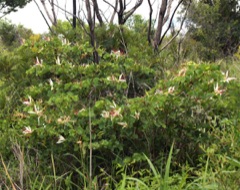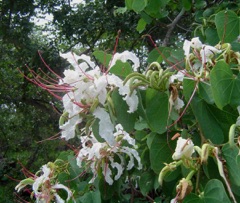 |
|
BT Wursten zambiaflora.com |
 |
| BT Wursten zambiaflora.com |
Translate this page:
Summary
Physical Characteristics

 Bauhinia petersiana is a deciduous Tree growing to 7 m (23ft) by 7 m (23ft) at a fast rate.
Bauhinia petersiana is a deciduous Tree growing to 7 m (23ft) by 7 m (23ft) at a fast rate.
See above for USDA hardiness. It is hardy to UK zone 9.
Suitable for: light (sandy) and medium (loamy) soils and prefers well-drained soil. Suitable pH: mildly acid, neutral and basic (mildly alkaline) soils. It cannot grow in the shade. It prefers dry or moist soil.
UK Hardiness Map
US Hardiness Map
Synonyms
Bauhinia macrantha Oliv. Bauhinia serpae Ficalho & Hiern Perlebia macrantha (Oliv.) A.Schmitz Perlebia petersiana (Bolle) A.Schmitz
Plant Habitats
Edible Uses
Edible Parts: Oil Root Seed Seedpod
Edible Uses: Coffee Drink Oil
Seed - cooked. Roasted and eaten like nuts, when they are considered a delicacy[299 ]. The seeds can be harvested whilst immature - the whole green pod is briefly roasted and then the seeds removed and eaten[775 ]. A meal made from the pounded seeds is eaten[299 ]. The seeds can be eaten green, but ripe seeds are usually roasted, peeled, and pounded into a pleasant-tasting, coarse meal[322 ]. The mature seeds are roasted and ground into a powder then used as a substitute for coffee[299 , 775 ]. Immature seedpods - cooked[299 ]. They can be roasted or boiled[299 ]. Root - roasted[775 ]. The core of the root is rejected and only the outer portion eaten[775 ]. Mainly a famine food, it is seldom eaten at other times[775 ]. An oil is obtained from the seed[299 ]. The principal fatty acids in the seed oil are linoleic acid (45%), oleic acid (26%), palmitic acid (16%) and stearic acid (7%)[299 ].
References More on Edible Uses
Medicinal Uses
Plants For A Future can not take any responsibility for any adverse effects from the use of plants. Always seek advice from a professional before using a plant medicinally.
Antidiarrhoeal Antitussive Skin
The leaves are boiled, the steam inhaled and the cooled-down liquid drunk to cure common cough[299 ]. The pounded leaves, mixed with salt, are boiled and the warm liquid is sprinkled on wounds to promote healing[299 ]. An infusion of the roots is used to treat dysmenorrhoea and female infertility[299 ]. A decoction of the macerated roots is drunk as a remedy for diarrhoea[299 ]. The roots and leaves contain tannins[299 ].
References More on Medicinal Uses
The Bookshop: Edible Plant Books
Our Latest books on Perennial Plants For Food Forests and Permaculture Gardens in paperback or digital formats.

Edible Tropical Plants
Food Forest Plants for Hotter Conditions: 250+ Plants For Tropical Food Forests & Permaculture Gardens.
More

Edible Temperate Plants
Plants for Your Food Forest: 500 Plants for Temperate Food Forests & Permaculture Gardens.
More

More Books
PFAF have eight books available in paperback and digital formats. Browse the shop for more information.
Shop Now
Other Uses
References More on Other Uses
Cultivation details
Management: Standard Staple Crop: Protein-oil Wild Staple Crop
Bauhinia petersiana is a plant of moist to arid areas in the tropics, where it can be found at elevations up to 1,850 metres[299 ]. The plant can tolerate some frost and can be found in areas experiencing as little as 350mm of rain in a year[299 ]. Requires a sunny position in a well-drained, preferably light, soil. Although many species within the family Fabaceae have a symbiotic relationship with soil bacteria, this species is said to be devoid of such a relationship and therefore does not fix atmospheric nitrogen[299 ].
Carbon Farming
-
Management: Standard
Plants grow to their standard height. Harvest fruit, seeds, or other products. Non-Destructive management systems.
-
Staple Crop: Protein-oil
(16+ percent protein, 16+ percent oil). Annuals include soybeans, peanuts, sunflower seeds. Perennials include seeds, beans, nuts, and fruits such as almond, Brazil nut, pistachio, walnut, hazel, and safou.
-
Wild Staple Crop
Some wild plants have strong historical or contemporary use. Although they are not cultivated crops, they may be wild-managed.
References Carbon Farming Information and Carbon Sequestration Information
Temperature Converter
Type a value in the Celsius field to convert the value to Fahrenheit:
Fahrenheit:
The PFAF Bookshop
Plants For A Future have a number of books available in paperback and digital form. Book titles include Edible Plants, Edible Perennials, Edible Trees,Edible Shrubs, Woodland Gardening, and Temperate Food Forest Plants. Our new book is Food Forest Plants For Hotter Conditions (Tropical and Sub-Tropical).
Shop Now
Plant Propagation
Seed - Cuttings Layering
Other Names
If available other names are mentioned here
Chingando, Imondo, Michingando, Mpando, Mpandula, Mpapa, Muauwa, Mubondo, Mumwando, Mun’ando, Mupondo, Muuwa
Native Range
AFRICA: Tanzania, Democratic Republic of the Congo (southeast), Angola (south), Mozambique, Malawi, Zambia, Zimbabwe, Botswana, Namibia, South Africa (Gauteng, Limpopo, North-West)
Weed Potential
Right plant wrong place. We are currently updating this section.
Please note that a plant may be invasive in one area but may not in your area so it's worth checking.
Conservation Status
IUCN Red List of Threatened Plants Status : This taxon has not yet been assessed

Growth: S = slow M = medium F = fast. Soil: L = light (sandy) M = medium H = heavy (clay). pH: A = acid N = neutral B = basic (alkaline). Shade: F = full shade S = semi-shade N = no shade. Moisture: D = dry M = Moist We = wet Wa = water.
Now available:
Food Forest Plants for Mediterranean Conditions
350+ Perennial Plants For Mediterranean and Drier Food Forests and Permaculture Gardens.
[Paperback and eBook]
This is the third in Plants For A Future's series of plant guides for food forests tailored to
specific climate zones. Following volumes on temperate and tropical ecosystems, this book focuses
on species suited to Mediterranean conditions—regions with hot, dry summers and cool, wet winters,
often facing the added challenge of climate change.
Read More
Expert comment
Author
Bolle
Botanical References
Links / References
For a list of references used on this page please go here
A special thanks to Ken Fern for some of the information used on this page.
Readers comment
| Add a comment |
|
If you have important information about this plant that may help other users please add a comment or link below. Only comments or links that are felt to be directly relevant to a plant will be included. If you think a comment/link or information contained on this page is inaccurate or misleading we would welcome your feedback at [email protected]. If you have questions about a plant please use the Forum on this website as we do not have the resources to answer questions ourselves.
* Please note: the comments by website users are not necessarily those held by PFAF and may give misleading or inaccurate information.
To leave a comment please Register or login here All comments need to be approved so will not appear immediately.
|
Subject : Bauhinia petersiana
|
|
|
|